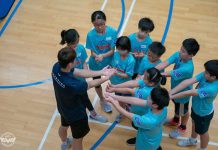As more and more schools teach Chinese in Putonghua, teachers, parents and students tell us whether they think it’s a better way to learn
Reporters: Lindy Wong and Ben Lam
It is recess time and the students bow and greet their teacher respectfully in the corridor. “Ni hao [hello],” the teacher says, and the students reply: “Laoshi zao [good morning teacher].” They are speaking in Putonghua but none of them are native Putonghua speakers. Scenes like this take place in hundreds of Hong Kong schools every day.
They are so-called Putonghua as Medium of Instruction, or PMI, schools that conduct Chinese lessons in Putonghua. Since 2001, Hong Kong has been pursuing a policy of “bi-literacy and trilingualism”, highlighting the equal importance of Cantonese, English and Putonghua in education, the workplace and public life. In response, more schools have since become PMI schools, hoping to enhance their students’ Putonghua proficiency.
According to Lam Kin-ping, associate director of the Centre for Research and Development of Putonghua Education, the numbers of PMI primary and secondary schools have increased three times and two times respectively since 2007.
Today, there are more than 350 PMI primary schools and 200 PMI secondary schools in Hong Kong. However, those figures need to be taken with a grain of salt as the extent to which Putonghua is used as a medium of instruction varies from school to school. While some schools may use Putonghua to teach Chinese to all classes in one form, some may use it in just one or two classes.
Teacher Ting, who preferred not to give his full name, teaches Chinese at a PMI secondary school in Tai Wai. He believes there are several reasons why PMI teaching is so popular today. “Hong Kong and Macau are the only regions where it is still Cantonese dominant. Shifting to PMI enhances emotional ties between people in Hong Kong and their motherland,” says Ting. “PMI schools meet the market demand. Many parents today want their children to speak Putonghua more fluently.”
Apart from parents, some scholars also support PMI education, which they believe is a more legitimate and efficient way to learn the language. This is because you can write exactly what you would speak. The Centre for Research and Development of Putonghua Education’s Lam Kin-ping is one of them.
“You can now write what you hear and speak in Putonghua. Improvement in writing is the most obvious; primary school students who learn Chinese in Putonghua can easily write up to 600 words without major grammatical mistakes, as opposed to 300 words when they learn in Cantonese,” Lam says.
Others, however, point out there is no definitive proof that Cantonese speakers learn the written Chinese language any better if they are taught in Putonghua. Tang Sze-wing, associate professor of the Department of Chinese Language and Literature at the Chinese University of Hong Kong, says: “We have yet to see empirical evidence that shows a strong positive correlation between PMI education and advancement in writing ability, or Chinese proficiency in general.”
“It’s true that you can write what you say in Putonghua,” says Tang but he believes every road leads to Rome. “It really depends what your objective is. If you want to explain and make students understand the language system of standardised modern Chinese, it may be better to choose a language that students are more familiar with.”
Tang suggests Cantonese may be preferable for local students who speak mostly Cantonese in everyday life.
This view is supported by Lau Shiu-kin, a teacher at Wai Kiu College. Lau teaches Chinese in both Cantonese and Putonghua. “Students are more eager and confident to express themselves in Cantonese,” he says.
Lau stresses the medium of instruction affects not only the students, but also the teachers. Lau says he needs to spend more time on preparation in order “to be fluent” for PMI lessons, whereas when teaching in Cantonese, he can crack jokes more naturally. “Using Cantonese can spice up the lesson,” Lau says.
Teacher Ting, the Chinese teacher from the PMI secondary school in Tai Wai, says the lack of specific training programmes for teachers to teach Chinese in Putonghua might affect the effectiveness of PMI education.
“There are short-term Putonghua courses you can take to learn the language, but to teach in it is another issue,” he says. “It has taken me five years to get used to teaching Chinese in Putonghua.”
Despite the rapid increase in PMI schools, government support has been limited. It was only in 2008 that the government’s advisory body, the Standing Committee on Language Education and Research (SCOLAR), launched a subsidy scheme to assist local primary and secondary schools that intend to carry out PMI education. SCOLAR has set aside HK$200 million for a four-year scheme to provide vocational training for Chinese teachers and to develop relevant teaching materials.
The scheme has attracted a total of 132 primary schools and 28 secondary schools. However, the figure falls short of an initial target to see one secondary school participating for every three primary schools. Uptake from secondary schools has been disappointing.
Although financial assistance is now available, Tse Shek-kam, director of the Centre of Advancement of Chinese Language Education and Research at the University of Hong Kong, criticises many PMI schools for not being up to standard. “They are just doing it because people are asking for it,” Tse says.
According to Tse, PMI education is only beneficial to students when it is implemented appropriately. He believes students who are in Primary Three or below should not have PMI education because they have not had time to establish a solid Cantonese foundation.
“Knowing how to speak the language is only the first step. There is something more to it; we should not take Cantonese for granted,” says Tse, who opposes the idea that the mother tongue can be mastered naturally.
Instead of taking an all-or-nothing approach, Tse suggests schools should adopt an integrated teaching method when carrying out PMI education. “A transitional period allows students to be better prepared for a new language,” Tse says. He also believes PMI education should only be carried out after students have acquired a certain level of knowledge of Putonghua.
However, many parents do not think this way. Yonne Chan Man-yee, whose daughter has been taught Chinese in Putonghua for three years, thinks that PMI education should be carried out as early as possible so that students can practise the language (Putonghua) more and become more fluent in it.
“I think it should start at Primary One,” Chan says. She believes PMI education provides an excellent opportunity for students to learn Putonghua, which is useful, if not essential, in today’s society. Chan lists examples of famous mainland and Taiwanese writers whose mother tongue is Putonghua. She extrapolates that students’ writing ability may improve if they speak and learn to write Chinese in Putonghua.
Yet, she cannot say whether her daughter’s writing has benefited in this way because she has never read any of her daughter’s compositions since she entered a PMI secondary school.
As for the students themselves, most of those who spoke to Varsity support PMI education in general. May Chow Wing-man, a graduate from Kiangsu-Chekiang College (Shatin), says although she did not notice a significant improvement in her Chinese proficiency after entering a PMI school, she believes PMI education has already given her more opportunities to practise Putonghua.
Tracy Lee Hiu-ying, who also graduated from Kiangsu-Chekiang College (Shatin), recalls her first year in the PMI school. “I did not attend a PMI primary school, but it was okay. The books were still in Chinese, and I had no difficulty understanding what the teacher said, even when it was in Putonghua,” she says.
However, not all students have had pleasant experiences with PMI education. University student Joanna Cheng Yuen-ling says her teachers “spent too much time on pronunciation of words” instead of teaching Chinese culture or grammar when she was at school.
While teaching Chinese in Putonghua provides students with a space where they can practise speaking Putonghua, it is important not to lose sight of the fact that the main objective of Chinese language classes is to improve students’ ability and proficiency in the written language.
“It is important that we all keep in mind that PMI education is still about teaching Chinese, but not Putonghua pronunciation,” says Sze Hung-hung, a Chinese teacher from Wai Kiu College. “The increase in Putonghua proficiency is only a sweet bonus.”











































